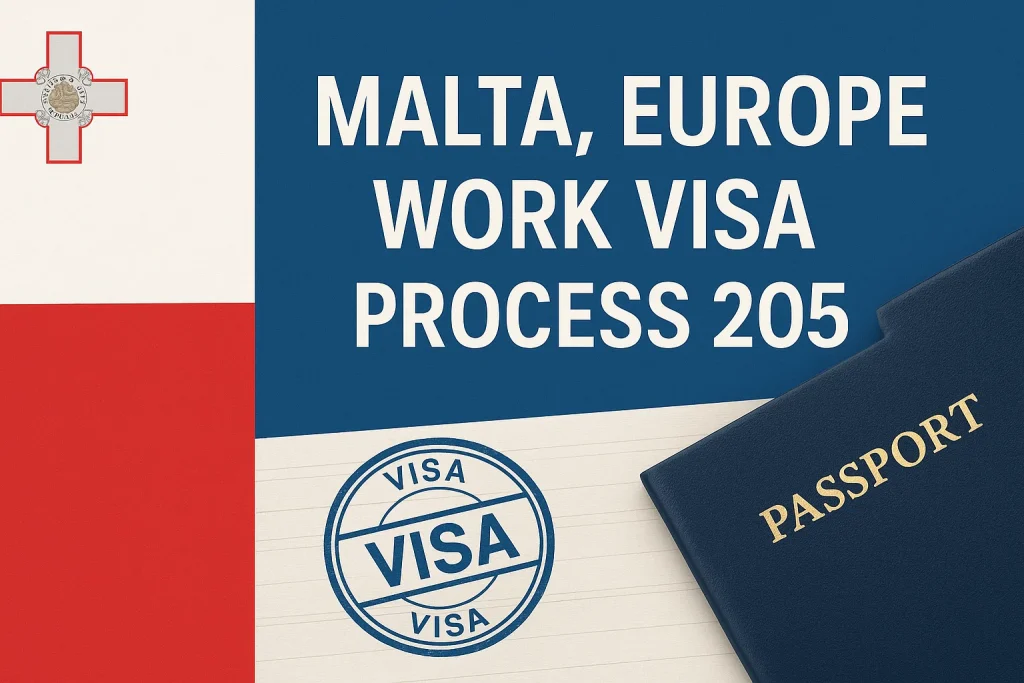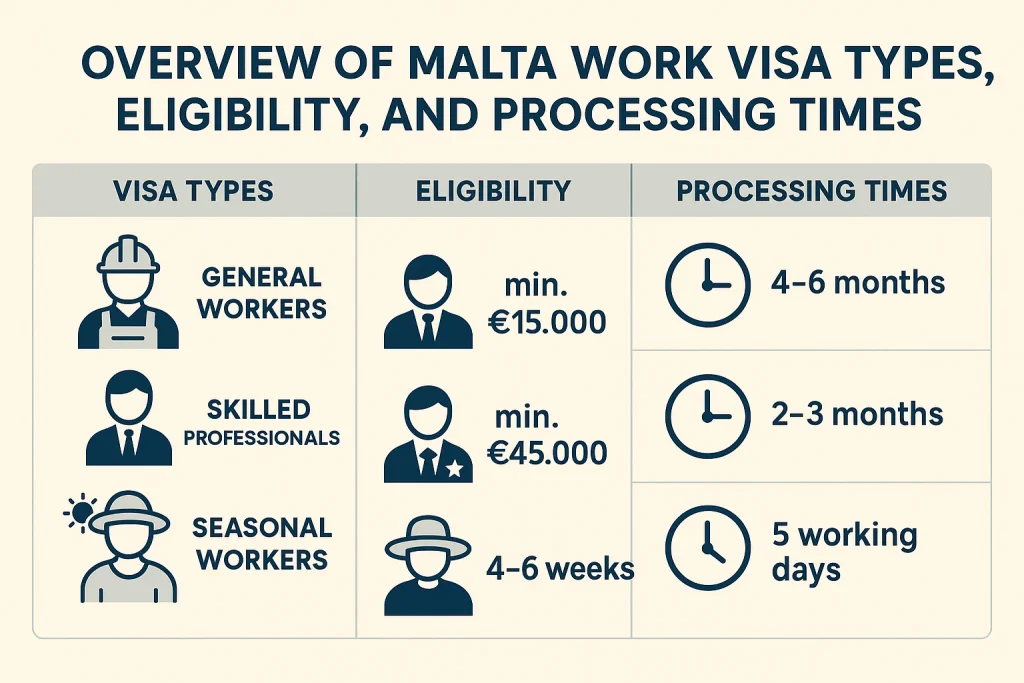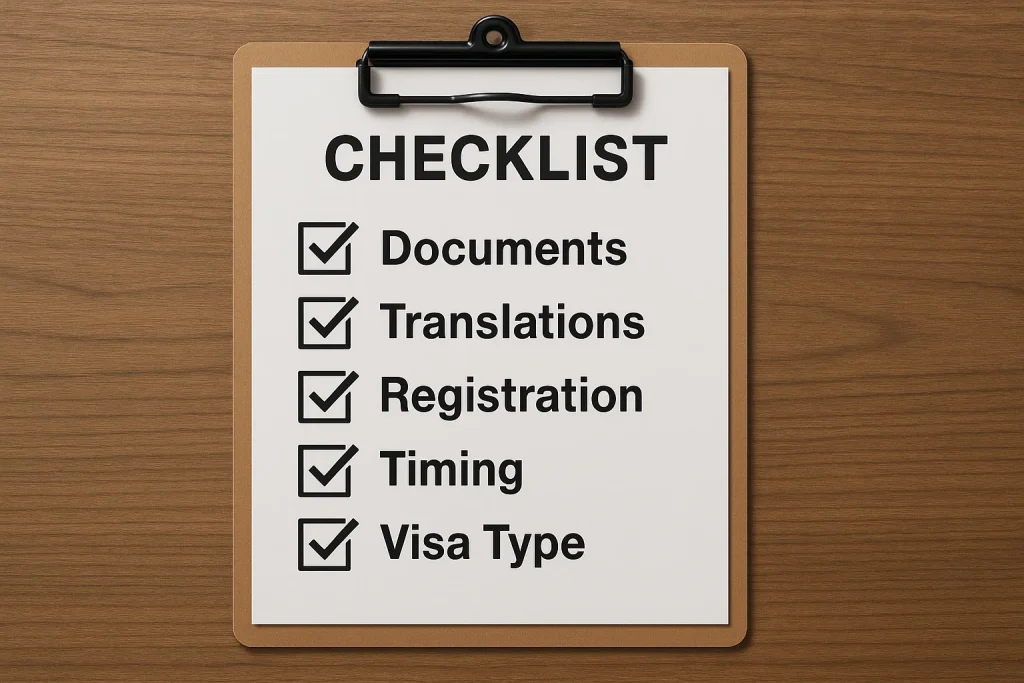If you’re planning to work in Malta in 2025, you’ll first need to choose the right type of work visa. Malta offers several options, depending on your job, experience level, and how long you plan to stay. Here’s a quick overview of the most common work visa types and who they’re for.

Single Permit for Employment
This is the most popular work visa in Malta. It allows non-EU nationals to live and work in the country legally for more than six months.
- It’s a combined work and residence permit.
- Your employer in Malta usually starts the application process on your behalf.
- The Identity Malta Agency handles the final approval.
This is a good fit if you already have a job offer and plan to stay for a year or longer.
EU Blue Card Malta
If you’re a highly skilled worker with a university degree and a strong job offer, the EU Blue Card might be right for you.
- You need a valid job offer in a high-skill position.
- Your salary must be at least 1.5 times the average gross annual salary in Malta.
- It allows easier mobility across EU member states for work.
This is best for professionals in sectors like IT, engineering, finance, and healthcare.
Key Employee Initiative (KEI)
The Key Employee Initiative is designed to fast-track applications for top professionals.
- Processing time is just 5 working days.
- It’s for managerial or highly technical positions.
- The minimum salary requirement is around €30,000 per year.
This visa is ideal for experienced professionals joining startups, financial firms, or IT companies.
Seasonal & Temporary Work Visas
If you’re coming to Malta for short-term jobs—like summer tourism, construction, or agriculture—you’ll need a temporary employment visa.
- These are usually valid for 6 months or less.
- You’ll still need a valid job offer from a Maltese company.
- Employers apply directly to the Jobsplus office.
These are great for students, recent graduates, or anyone looking for short work experiences abroad.

Overview of Malta Work Visa Types, Eligibility, and Processing Times
| Visa Type | Target Group | Processing Time | Minimum Salary | Valid For |
| Single Permit | General workers with job offers | 4–6 weeks | Market rate | 1 year (renewable) |
| EU Blue Card | Skilled professionals | 3–6 weeks | 1.5x avg. gross salary | 1–4 years |
| Key Employee Initiative (KEI) | Top-tier professionals | 5 working days | €30,000+ | 1 year (renewable) |
| Seasonal/Temporary Visa | Short-term/seasonal workers | 2–4 weeks | Depends on job sector | 6 months max |
Eligibility Criteria for a Malta Work Visa
Understanding the basic requirements can save you from delays and rejections. Whether you’re applying for a Single Permit or a Blue Card, the checklist is mostly the same—but there are small differences based on the visa type.
General requirements (age, nationality, etc.)
- You must be at least 18 years old.
- If you’re from a non-EU country, you’ll need a valid passport with at least 6 months’ validity.
- Nationals from countries with visa restrictions may need a visa before entering Malta. You can check your country’s status on the Malta Visa Policy page.
Qualifications and work experience
- Most work visas require relevant qualifications (diplomas, certificates, degrees).
- Some jobs may ask for minimum work experience (usually 2+ years).
- For the EU Blue Card, a recognized university degree is a must.
If you’re not sure if your credentials qualify, I recommend using the MQRIC tool to check recognition in Malta.
Job offer and employer sponsorship
- You must have a formal job offer or employment contract from a Malta-based company.
- Your employer must submit supporting documents like a position description, business license, and proof that the role couldn’t be filled locally.
- Many job seekers secure jobs through Jobsplus or popular platforms like EURES.
Language and health requirements
- While English is widely spoken, some jobs (especially in healthcare or public services) may require language proficiency certificates.
- You’ll need proof of good health—usually a certificate from a licensed doctor.
- Some permits may also require health insurance during your stay.
Step-by-Step: How to Apply for a Malta Work Visa in 2025
Here’s a simple roadmap to get your work visa for Malta. The application can feel a bit long, but if you follow each step carefully, you’ll avoid unnecessary delays.
Step 1 – Get a valid job offer
Before anything else, you’ll need to secure a job offer from a registered employer in Malta.
- Look for companies that offer visa sponsorship.
- Make sure your contract includes details like salary, job duties, and duration of employment.
Most employers know how the visa system works, but it’s always good to confirm that they’re willing to support your permit process.
Step 2 – Employer files a Single Permit application
In most cases, it’s the employer who submits your application to Identity Malta.
- This includes forms, your job offer, and company documents.
- You’ll also need to sign a consent form allowing the employer to apply on your behalf.
- Employers must prove they tried to hire locally before offering the job to a foreign worker.
Step 3 – Submit documents to Identity Malta
Once the application is received, Identity Malta will ask you for personal documents. These often include:
- Valid passport
- Passport-size photo
- Proof of accommodation
- Bank statements or salary slips
- Health certificate
Make sure every document is translated into English and properly certified. If anything’s missing or incorrect, it can delay your approval by weeks.
Step 4 – Wait for approval and collect residence permit
Processing times vary depending on the visa type.
- Single Permits usually take 4–6 weeks.
- Key Employee Initiative permits take just 5 working days.
- Once approved, you’ll get a residence card that also serves as your work permit.
If you’re applying from outside Malta, you’ll be granted a D Visa to enter the country, then collect your card once you arrive.
Required Documents for Malta Work Visa
Getting your Malta work visa means submitting the right papers—on time and in order. Based on my experience helping others navigate visa systems, I know how easy it is to miss a small detail and face delays. Here’s what you’ll need in 2025 to avoid that.
Essential paperwork for 2025
You must prepare these core documents:
- Valid passport (with at least 6 months left before it expires)
- Passport-size photos (2 recent ones that meet ICAO standards)
- Signed employment contract from a Malta-based employer
- Proof of qualifications—degrees, diplomas, or certificates
- Curriculum Vitae (CV) in English, updated and formatted clearly
- Police clearance certificate from your home country
- Health certificate from a licensed doctor
Make sure each document is either original or a certified copy. If anything’s not in English, have it officially translated by a certified translator.
Visa-specific document checklist
Here’s a breakdown of what’s needed for different work visa types.
| Document | Single Permit | EU Blue Card | KEI | Seasonal/Temp |
| Valid Passport | ✅ | ✅ | ✅ | ✅ |
| Employment Contract | ✅ | ✅ | ✅ | ✅ |
| Academic Qualifications | ✅ | ✅ (University degree) | ✅ | ❌ |
| CV in English | ✅ | ✅ | ✅ | ✅ |
| Health Certificate | ✅ | ✅ | ✅ | ✅ |
| Police Clearance | ✅ | ✅ | ✅ | ✅ |
| Proof of Salary | ❌ | ✅ | ✅ | ❌ |
Keep both digital and printed copies handy. Some embassies or employers may request original hard copies even after digital submission.
Malta Work Visa Fees and Processing Time
Knowing the costs and how long it takes helps you plan better. Many people I’ve guided felt more confident once they had a clear timeline and budget.
Fee structure for different visa types
Visa fees in Malta are quite reasonable when compared to other EU countries. But keep in mind, they may change each year, so always double-check with the Identity Malta Agency.
| Visa Type | Application Fee (EUR) | Renewal Fee (EUR) |
| Single Permit | €280.50 | €50–70 |
| EU Blue Card | €140.00 | €100 |
| Key Employee Initiative (KEI) | €300.00 | €50–70 |
| Seasonal/Temporary Visa | €100.00 | N/A |
You might also need to pay for document translation, passport photos, and a health check, depending on your country.
Average processing timelines
Processing time varies based on the type of visa and your specific case.
- Single Permit – 4 to 6 weeks
- EU Blue Card – 3 to 6 weeks
- KEI Visa – 5 working days
- Seasonal Visa – 2 to 4 weeks
Remember: If your documents are incomplete or unclear, it could take much longer. I always recommend double-checking your application before submission and keeping a copy of every document for your records.
Post-Arrival Steps in Malta
So, you’ve got your visa and landed in Malta. What next? I’ve helped several professionals settle into their new lives abroad, and here’s what I always suggest once you arrive.
Registering your residence
Within 7 days of arrival, you must register your address.
- Visit the Expatriates Unit of the Identity Malta Agency.
- Bring your passport, Single Permit approval letter, rental agreement, and passport photos.
- You’ll receive a residence card, which you’ll need to show for ID checks, healthcare, and more.
This step is required for all non-EU nationals staying in Malta for over 90 days. Skipping it can lead to fines or even deportation.
Getting your tax and social security numbers
- Ask your employer to register you with Jobsplus and the Malta Inland Revenue Department.
- You’ll be assigned a social security number, which lets you access benefits and healthcare.
- You’ll also get a tax number used for income deductions and annual filings.
You can learn more about this on the Government of Malta’s official site.
Opening a local bank account
To get paid, you’ll need a local bank account. Most Maltese banks require:
- Your residence card
- Job contract
- Proof of address
- Initial deposit (usually around €50–€100)
Major banks like Bank of Valletta, APS Bank, and HSBC Malta are widely available. Some even offer special accounts for foreign workers.
Living and Working in Malta: Lifestyle, Wages, and Rights
Moving to a new country is a big step—not just for your job, but for your lifestyle too. I’ve spoken to several expats who moved to Malta, and their experiences reflect a mix of excitement and adjustment. Here’s what to expect when living and working in Malta.
Lifestyle in Malta
Malta offers a sunny Mediterranean lifestyle with a low crime rate and a close-knit community. The cost of living is moderate, though certain areas like Sliema and St. Julian’s can be pricier.
You’ll find a mix of:
- English-speaking locals and expats from around the world
- Affordable public transport (buses run across the island)
- Fresh seafood and Mediterranean cuisine
- Rich culture with festivals, music, and ancient history
It’s also worth noting that English is one of Malta’s official languages, so day-to-day communication is easy for most foreigners. For many, it’s a smooth cultural transition.
Average wages in Malta
Your salary in Malta depends on your job, skills, and visa type. Based on recent data from Eurostat, here’s a general idea of what you might earn:
| Job Role | Average Monthly Salary (EUR) |
| IT Developer | €2,200 – €3,000 |
| Hospitality Staff | €1,000 – €1,300 |
| Accountant | €1,800 – €2,400 |
| Healthcare Assistant | €1,500 – €2,000 |
| Administrative Support | €1,200 – €1,600 |
Even though wages in Malta are slightly lower than in countries like Germany or the Netherlands, the cost of living is also lower, especially when it comes to rent and utilities outside the major tourist zones.
Workplace rights and protections
In Malta, workers are protected under EU labor law and national employment laws. As a foreign worker, you’re entitled to:
- Fair pay and timely salary
- Paid leave (including sick and annual leave)
- Equal treatment regardless of nationality
- Safe working conditions
To understand your full rights, visit the Employment and Industrial Relations Department of Malta. I always advise reading your contract carefully and clarifying any unclear terms with your employer or a legal advisor.
Common Mistakes to Avoid During the Malta Work Visa Process

From what I’ve seen, even highly skilled professionals can face delays because of small mistakes. Here are the most common errors—and how to avoid them.
Top 5 mistakes applicants make
- Missing or expired documents
Always check the expiry dates on your passport, police clearance, and health certificates. - Inaccurate translations
Poor translations or unofficial versions often lead to rejections. Always use certified translation services. - Skipping the residence registration step
Not registering within 7 days of arrival can cause legal issues, including penalties or future visa problems. - Applying too close to your job start date
Always apply at least two months in advance, especially for Single Permit applications. - Choosing the wrong visa type
Make sure your job role and qualifications align with the visa you apply for. For example, KEI visas are for highly specialized roles only.
Being prepared and asking the right questions early can save you time, money, and stress.
Conclusion: Your Path to Malta Starts Here
Starting your work journey in Malta in 2025 is not just possible—it’s more streamlined than ever. With a clear application path, affordable visa fees, and a welcoming lifestyle, Malta has become a favorite destination for professionals around the world.
I’ve personally seen how proper preparation leads to success. From gathering the right documents to understanding local rules, every step counts. Whether you’re aiming for the Single Permit, the EU Blue Card, or the Key Employee Initiative, knowing the process puts you in control.
Still have questions? Take your next step by exploring official sites like Identity Malta or local job boards to get started. Malta’s doors are open—now it’s your turn to walk through them.